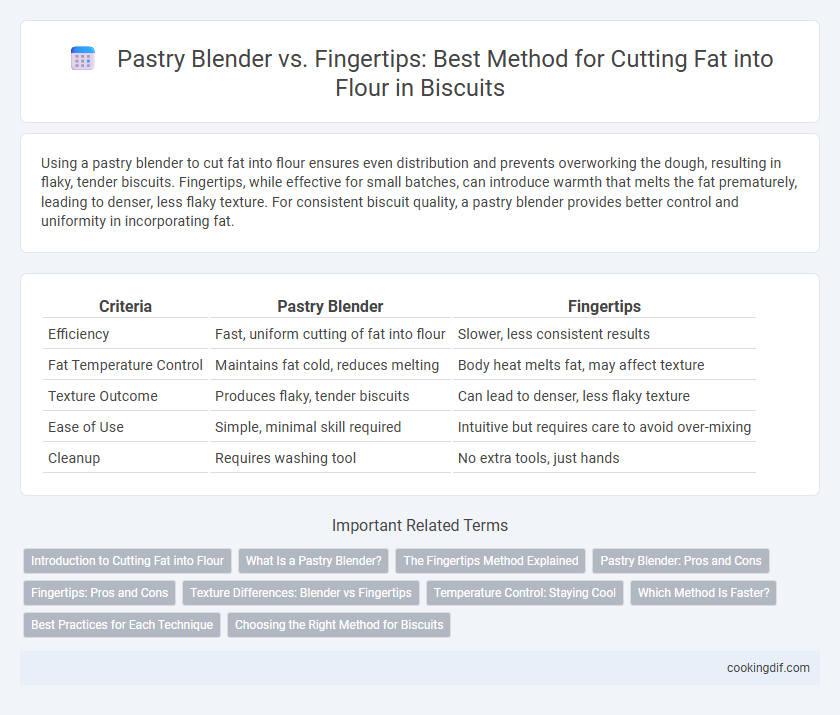Using a pastry blender to cut fat into flour ensures even distribution and prevents overworking the dough, resulting in flaky, tender biscuits. Fingertips, while effective for small batches, can introduce warmth that melts the fat prematurely, leading to denser, less flaky texture. For consistent biscuit quality, a pastry blender provides better control and uniformity in incorporating fat.
Table of Comparison
| Criteria | Pastry Blender | Fingertips |
|---|---|---|
| Efficiency | Fast, uniform cutting of fat into flour | Slower, less consistent results |
| Fat Temperature Control | Maintains fat cold, reduces melting | Body heat melts fat, may affect texture |
| Texture Outcome | Produces flaky, tender biscuits | Can lead to denser, less flaky texture |
| Ease of Use | Simple, minimal skill required | Intuitive but requires care to avoid over-mixing |
| Cleanup | Requires washing tool | No extra tools, just hands |
Introduction to Cutting Fat into Flour
Cutting fat into flour is a crucial step in biscuit making that affects the texture and flakiness of the final product. A pastry blender efficiently breaks down cold butter or shortening into small, pea-sized pieces, creating a uniform mixture that traps steam and produces flaky layers. Using fingertips generates warmth that can soften the fat prematurely, potentially leading to denser biscuits with less distinct layers.
What Is a Pastry Blender?
A pastry blender is a handheld kitchen tool designed with a series of parallel wires or blades attached to a handle, used to cut fat into flour efficiently for biscuits and other pastries. It ensures even distribution of butter or shortening in the dough, creating a flaky texture by preventing over-mixing and maintaining small fat pieces. Using fingertips can warm the fat, leading to a denser biscuit, while a pastry blender helps maintain cold fat for optimal crumbly results.
The Fingertips Method Explained
The fingertips method for cutting fat into flour in biscuit making involves gently pressing and rubbing the fat with your fingers until it resembles coarse crumbs, allowing better control over the texture. This approach helps maintain small chunks of fat that create flaky layers during baking, as the warmth from your hands softens the fat just enough without melting it completely. Compared to a pastry blender, fingertips provide a tactile sensitivity that can result in a more precise and delicate incorporation of fat, crucial for achieving tender, flaky biscuits.
Pastry Blender: Pros and Cons
A pastry blender efficiently cuts cold fat into flour, creating uniform, flaky layers essential for perfect biscuits. It reduces hand warmth transfer, preventing fat from melting prematurely, which helps maintain dough texture. However, pastry blenders can struggle with smaller batches or very cold fats, sometimes requiring additional effort to achieve consistency compared to using fingertips.
Fingertips: Pros and Cons
Using fingertips to cut fat into flour offers precise control over texture, allowing bakers to create a crumbly or flaky biscuit dough by feeling the fat's size and distribution. However, the warmth of fingertips can cause the fat to melt prematurely, potentially leading to denser, less flaky biscuits. This method is favored for small batches or delicate pastries but may require practice to avoid overworking the dough.
Texture Differences: Blender vs Fingertips
Using a pastry blender to cut fat into flour creates a more consistent coarse texture, which results in flakier biscuits with better lift due to even fat distribution. Fingertips tend to warm the fat, causing it to partially melt and blend unevenly, producing denser biscuits with a less distinct crumb structure. For optimal biscuit texture, the controlled, mechanical action of a pastry blender ensures uniform fat pieces that create desirable pockets of steam during baking.
Temperature Control: Staying Cool
Using a pastry blender to cut fat into flour helps maintain a cooler dough temperature by minimizing direct heat transfer from hands, which is crucial for flaky biscuit layers. Fingertips can quickly warm the fat, causing it to soften and blend too thoroughly into the flour, reducing flakiness. Temperature control during this step ensures the fat remains solid, creating distinct pockets that result in tender, flaky biscuits.
Which Method Is Faster?
Using a pastry blender is faster than fingertips for cutting fat into flour because the metal blades quickly and evenly break down the fat, creating a consistent texture necessary for flaky biscuits. Fingertips, while effective, tend to warm the fat, causing it to soften and slow the process, which can affect the final biscuit quality. Professional bakers prefer pastry blenders for speed and precision in achieving the ideal dough consistency.
Best Practices for Each Technique
Using a pastry blender ensures even distribution of cold fat into flour, creating uniform crumbs essential for flaky biscuits, while fingertips risk warming the fat too quickly, leading to denser textures. For best results with a pastry blender, press and cut fat until pea-sized pieces form, maintaining the fat's cold temperature to promote steam during baking. When favoring fingertips, work swiftly to minimize heat transfer, gently rubbing fat into flour to avoid overworking the dough and preserving biscuit tenderness.
Choosing the Right Method for Biscuits
Using a pastry blender to cut fat into flour for biscuits ensures even distribution, creating a tender, flaky texture by preventing overworking the dough. Fingertips, while convenient, risk warming the fat too much, resulting in denser biscuits with less lift. For precise control and consistent biscuit quality, a pastry blender is the preferred tool among bakers.
Pastry blender vs fingertips for cutting fat into flour Infographic

 cookingdif.com
cookingdif.com